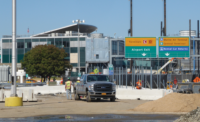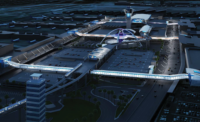The term “enabling” may have negative connotations to laypeople, but for airport builders, it’s all about progress. Almost every busy airport in the U.S. faces the common challenge of trying to expand and modernize existing infrastructure within a tight footprint full of existing roadways, facilities and traffic. “Enabling” is how contractors describe the process of shifting existing “chess pieces” to make room for new construction.
At Salt Lake City International Airport, that includes the extensive reconfiguring of the roadway and parking systems, utility relocations, a “quick turnaround facility” to allow up to 2,000 workers site access, and ground stabilization work, including some 15,000 stone-filled columns as deep as 40 ft in an ancient lake bed.

“We’re preparing for the big show,” says Leon Nelson, construction director with HD Construction, a joint venture of Holder and Big-D Construction, the construction manager-at-risk team for the originally $1.8-billion, 10-year Terminal Redevelopment Program (TRP). In May, the airline tenants and the city agreed to add a 30-gate north concourse to the TRP, increasing the total to $2.6 billion.
As with so many U.S. airport programs, the TRP plan experienced a delay due to the 2008 economic crisis, airline mergers and a decrease in regional jets. With that in mind, design for the new, HOK-led terminal “is built to be flexible,” says Michael Williams, program director with the Salt Lake City Dept. of Airports.
When ENR visited the airport a year ago as part of its “Low & Slow Across America’s Infrastructure” tour, soil stabilization work had just begun. “We have weak soils requiring surcharge—sands, silts, clays,” says Williams. Other enabling work on the 135 acres includes a new parking lot at the airport’s south end, a mile’s worth of new road, 12 miles of utility work and a 4-mile fence, to separate construction activity from airfield activity, says Brian Johnson, HD superintendent.
ENR revisited the site in August as part of the western leg of its “Project Runways: America’s Airport Infrastructure.”
Crews will install some 6,200 steel piles about 70 ft deep to support the future three-story terminal and concourse that will replace three current terminals and five concourses. The 1.7-million-sq-ft building will aim for LEED Gold certification. Salt Lake City airport, like just about every other, is striving to offset its carbon impact, despite big capital plans. But San Francisco’s and Seattle’s airports may very well be the leaders in that effort.
Sweatless in Seattle

Seattle-Tacoma International Airport (Sea-Tac) doesn’t have much capital construction happening now, but that will change dramatically over the next 20 years because at least $10 billion of work is in the master-planning phase for expanded terminal facilities. Much of that planning is fueled by Delta Airlines’ aggressive push to claim Sea-Tac as a major hub, a status held by Alaska Airlines.
“We have concluded that, after we complete the expansion and renovation of the North Satellite concourse and the new arrivals facility, we additionally need 35 gates at Sea-Tac,” says Elizabeth Leavitt, senior director of environment and sustainability for the Port of Seattle, the agency that runs Sea-Tac. “The current plan on delivering those gates is to create a north pier system—a set of terminal complexes where passengers will connect to the existing terminal.” The program also will feature a south aviation port area, supporting cargo and maintenance facilities, and potentially a new airside and landside people mover.
Construction is getting underway on a nearly $550-million expansion and upgrade of the 40-year-old north satellite facility, with sole tenant Alaska Airlines contributing about $37 million. Reflecting common airport trends, the facility will receive more concessions; high-tech features, such as interactive signage; and aesthetics highlighting the Northwest region. The current terminal “looks and feels like a 1970s-era building in a high-tech region,” says Sea-Tac spokesman Brian DeRoy.
The 35 new gates for the rest of the airline tenants are needed to accommodate consistent, significant growth at Sea-Tac, currently the nation’s fastest-growing hub, with more than 42 million passengers last year. “If we could be building gates today, I’d be happy,” says Leavitt. “That’s why, at [our] risk, we will proceed with detailed planning and definition work during environmental review.” The airport is looking to hire up to four firms via indefinite-delivery/indefinite-quantity contracts for project definition.
“We will [simultaneously] integrate sustainability into the master plan from the beginning,” adds Leavitt. “We added criteria so that it’s not an afterthought. We’ve done that in a couple of big buckets. One is where and what we build. How do you place these facilities in a way to allow for the most efficient airport possible? Then, we look at how we will build—what level of LEED, what’s the reduction in footprint, what’s the cost for that reduction. At end of the day, we know we cannot offset all the impact from a doubling of passengers, so we’ll work on how to operate the airport in the most sustainable way possible.”
To that end, the airport boasts what officials say is the largest preconditioned-air system of its kind—a central plant that chills water to 20°F, mixing it with 25% ethelyne glycol to provide air-conditioning to 69 gates.
That means pilots can turn off the airplane engines when parked at the gate but passengers still receive cool air. The system saves 5 million gallons in fuel and $15 million in costs a year, while reducing emission by 40,000 metric tons. Operational since 2013, the $43-million system received $22 million in federal grants under a voluntary emissions-reduction program.
Bay Area Boom
Visiting San Francisco International Airport (SFO) right after Sea-Tac was akin to visiting a fraternal twin. Like Sea-Tac, SFO has been pushing the envelope with its sustainability goals. Like Sea-Tac, SFO features quirky signage, plentiful art exhibits, trendy concessions and terminal features that reflect pride in the region. And like Sea-Tac, SFO is about to embark on a major capital program wherein sustainability is integrated at the outset.
All work on the FY2015-20 $6-billion capital plan is informed by a sustainability manual that goes beyond design and construction to offer guidelines that maximize the comfort and safety of people (ENR 3/17/14 p. 39). The program already has produced a $250-million, 65,000-sq-ft renovation of Terminal 3, with amenities such as a yoga room, private dressing rooms, high-tech gate lounges and an interactive play area.
In June, SFO broke ground on a $2.4-billion upgrade of Terminal 1 that will be delivered via three design-build teams. At the same time, SFO will aggressively pursue a goal of achieving net-zero environmental impact—with the help of committees of young engineers and architects, says Judi Mosqueda, SFO director of project management. “We are asking project teams to help us figure out how to do this,” she says.






Post a comment to this article
Report Abusive Comment